Conglomerate rock is a fascinating sedimentary stone composed of rounded gravel-sized or larger rock fragments cemented together, and at rockscapes.net, we’re here to show you everything about conglomerate rock. This comprehensive guide dives into the heart of conglomerate, exploring its formation, composition, uses, and how it differs from similar rocks, providing homeowners, landscapers, and designers with the knowledge to appreciate and utilize this unique stone in their projects. Let’s explore the interesting world of conglomerate rock, giving you the knowledge and inspiration you need for your next landscaping project, so keep reading to learn about clastic rocks, sedimentary geology, and the marvels of natural stone.
Table of Contents
- What Is Conglomerate Rock?
- What Are The Key Characteristics of Conglomerate Rock?
- What Is Conglomerate Rock Made Of?
- How Does Conglomerate Rock Form?
- Where Is Conglomerate Rock Found?
- Conglomerate vs. Breccia: What’s The Difference?
- What Are The Different Types of Conglomerate Rock?
- What Is Conglomerate Rock Used For?
- Conglomerate Rock in Landscaping: Ideas and Inspiration
- How to Identify Conglomerate Rock?
- What are Some Famous Conglomerate Formations Around The World?
- Is Conglomerate Rock Valuable?
- How to Maintain Conglomerate Rock in Your Landscape?
- What is Puddingstone Conglomerate?
- Conglomerate Rock on Other Planets
- FAQ about Conglomerate Rock
1. What is Conglomerate Rock?
Conglomerate rock is a clastic sedimentary rock distinguished by its coarse-grained texture, which comprises rounded clasts (fragments of other rocks or minerals) larger than two millimeters in diameter held together by a matrix of finer sediments (such as sand, silt, and clay) and cemented by minerals like calcite or quartz. In essence, conglomerate is like a naturally occurring concrete, showcasing the power of geological processes over time.
- Sedimentary Rock: Conglomerate falls under the category of sedimentary rocks, meaning it is formed from the accumulation and cementation of sediments. Sedimentary rocks cover a large portion of the Earth’s surface and provide valuable insights into past environments and geological history.
- Clastic Texture: The term “clastic” refers to the fact that conglomerate is composed of clasts, which are fragments of pre-existing rocks and minerals. This clastic texture gives conglomerate its distinctive appearance, with easily visible rounded pebbles or cobbles embedded in a finer-grained matrix.
- Compositional Variety: Conglomerate’s composition can vary widely depending on the source of the clasts. It may contain fragments of various rock types, including igneous (like granite or basalt), metamorphic (like gneiss or quartzite), and sedimentary rocks (like sandstone or limestone), as well as mineral grains like quartz and feldspar.
1.1 Why is Conglomerate Rock Important?
Conglomerate rock is important for several reasons:
- Geological Record: Conglomerate provides valuable information about past geological conditions. The size, shape, and composition of the clasts can indicate the source area, the distance of transport, and the energy of the depositional environment.
- Resource Exploration: Conglomerate can sometimes contain valuable mineral deposits, such as gold or uranium. Ancient riverbeds preserved as conglomerate rocks may act as “fossil placer deposits,” where heavy minerals have accumulated over time.
- Construction Material: While not as widely used as other types of rock, conglomerate can be used as a construction material, particularly for decorative purposes. Its unique appearance and durability make it suitable for creating visually appealing walls, pavements, and other landscape features.
Conglomerate’s story is written in stone—literally. It’s a tangible piece of Earth’s history, shaped by time and geological forces.
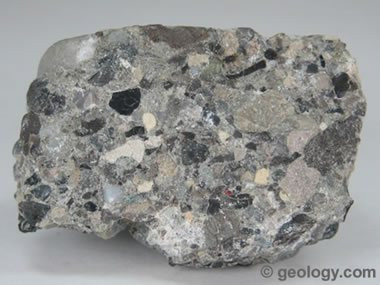 Conglomerate specimen with chert and limestone clasts
Conglomerate specimen with chert and limestone clasts
1.2 What does Conglomerate Rock Tell Us About Earth’s History?
The story of Earth’s history is told in the rounded stones and mineral cements that comprise conglomerate rock. The composition of the clasts provides clues about the source rocks that existed in the past. For example, finding granite clasts in a conglomerate indicates that granite mountains were present in the source area.
The degree of rounding of the clasts reflects the distance and duration of transport. Highly rounded clasts suggest that the sediments traveled a long distance and were subjected to extensive abrasion. The size and sorting of the clasts reveal information about the energy of the depositional environment. High-energy environments, such as fast-flowing rivers, can transport larger clasts, while low-energy environments, such as lakes, can only transport finer sediments.
According to research from Arizona State University’s School of Earth and Space Exploration, conglomerate rocks found on Mars indicate that water once flowed on the surface of the red planet.
2. What Are The Key Characteristics of Conglomerate Rock?
Conglomerate rock possesses a unique set of characteristics that make it easily identifiable and distinct from other types of rocks. Here are some of the key characteristics of conglomerate:
- Clast Size: Clasts are over two millimeters in diameter and are easily visible to the naked eye.
- Clast Shape: The clasts are rounded or sub-rounded, indicating that they have been transported and abraded by water or wind.
- Matrix: The clasts are embedded in a matrix of finer-grained sediments, such as sand, silt, and clay, which fills the spaces between the larger clasts.
- Cementation: The clasts and matrix are bound together by a cement, which is typically composed of minerals such as calcite, quartz, or iron oxides. The cementation process is what turns the loose sediments into solid rock.
- Composition: The composition of conglomerate can vary widely, depending on the source of the clasts. Conglomerate may contain fragments of various rock types and mineral grains.
- Texture: Conglomerate has a coarse-grained texture due to the presence of large clasts. The texture can range from clast-supported, where the clasts are in contact with each other, to matrix-supported, where the clasts are surrounded by the matrix.
- Color: The color of conglomerate can vary depending on the composition of the clasts, matrix, and cement. It can be various shades of gray, brown, red, or even multicolored.
- Porosity and Permeability: Conglomerate tends to have high porosity due to the spaces between the clasts. However, its permeability (the ability of fluids to flow through the rock) can vary depending on the size and connectivity of the pores.
- Hardness: Conglomerate’s hardness varies depending on the strength of the cement and the hardness of the clasts. Some conglomerates are relatively soft and easily weathered, while others are quite durable and resistant to erosion.
2.1 How Do These Characteristics Influence Its Uses?
These characteristics of conglomerate rock influence its potential uses in various ways:
- Aesthetic Appeal: The colorful clasts and coarse texture of conglomerate make it an attractive material for decorative purposes in landscaping and construction.
- Durability: The hardness and resistance to weathering of conglomerate determine its suitability for use as a building material or paving stone.
- Porosity and Permeability: The porosity and permeability of conglomerate affect its ability to drain water, which is an important consideration for landscaping applications.
- Weight: Conglomerate can be quite heavy due to the density of the rock fragments, which can affect its use in certain construction projects.
These characteristics are very useful when you are choosing what type of rock to use for a specific purpose.
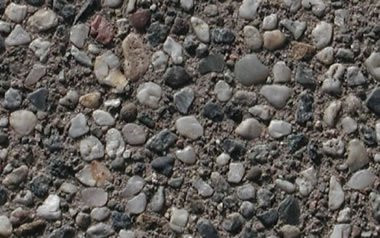 Close-up of conglomerate showing pebbles and sand
Close-up of conglomerate showing pebbles and sand
3. What Is Conglomerate Rock Made Of?
Conglomerate rock is a composite material, meaning it is made up of several different components. These components include:
- Clasts: These are the large, rounded fragments that make up the bulk of the rock. Clasts can be made of any type of rock or mineral, including:
- Igneous rocks: Granite, basalt, rhyolite
- Sedimentary rocks: Sandstone, limestone, shale
- Metamorphic rocks: Gneiss, schist, quartzite
- Minerals: Quartz, feldspar, chert
- Matrix: The matrix is the finer-grained material that fills the spaces between the clasts. It is typically made up of sand, silt, and clay-sized particles.
- Cement: The cement is the material that binds the clasts and matrix together. Common cementing minerals include:
- Calcite: A calcium carbonate mineral
- Quartz: A silicon dioxide mineral
- Iron oxides: Minerals such as hematite and goethite
3.1 How Does the Composition Affect Its Appearance and Properties?
The composition of conglomerate rock significantly affects its appearance and properties:
- Color: The color of conglomerate rock is influenced by the color of the clasts, matrix, and cement. For example, conglomerate with red iron oxide cement will have a reddish hue.
- Texture: The size, shape, and arrangement of the clasts determine the texture of the conglomerate. Conglomerate with large, well-rounded clasts will have a coarser texture than conglomerate with smaller, more angular clasts.
- Hardness: The hardness of conglomerate rock depends on the hardness of the clasts and the strength of the cement. Conglomerate with hard clasts and strong cement will be more resistant to weathering and erosion.
- Porosity and Permeability: The porosity and permeability of conglomerate rock are influenced by the size and connectivity of the pores between the clasts. Conglomerate with large, interconnected pores will be more porous and permeable than conglomerate with small, isolated pores.
The specific composition of a conglomerate rock can reveal a lot about its origin and formation.
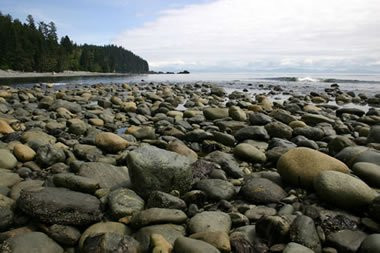 Beach with rounded rocks, a potential conglomerate source
Beach with rounded rocks, a potential conglomerate source
4. How Does Conglomerate Rock Form?
Conglomerate rock forms through a series of geological processes that transform loose sediments into solid rock:
- Weathering and Erosion: The process starts with the weathering and erosion of pre-existing rocks. Weathering breaks down rocks into smaller pieces through physical and chemical means. Erosion then transports these fragments away from their source.
- Transportation: The rock fragments are transported by water, wind, or ice. During transportation, the fragments are rounded and sorted by size. The farther the fragments travel, the more rounded they become.
- Deposition: Eventually, the rock fragments are deposited in a new location. This can occur in a variety of environments, such as riverbeds, beaches, or glacial outwash plains.
- Compaction: Over time, the deposited sediments are buried under layers of newer sediments. The weight of the overlying sediments compacts the underlying sediments, reducing the pore space between the fragments.
- Cementation: Finally, the sediments are cemented together by minerals that precipitate from groundwater. These minerals fill the remaining pore spaces and bind the rock fragments together, forming solid conglomerate rock.
4.1 What Environments are Conducive to Conglomerate Formation?
Conglomerate rock typically forms in high-energy environments where strong currents can transport and deposit coarse sediments, such as:
- Fast-flowing rivers: Rivers with strong currents can carry large rock fragments and deposit them in riverbeds and floodplains.
- Beaches: Beaches with strong waves can erode and transport rock fragments, rounding them and depositing them along the shoreline.
- Glacial outwash plains: Glaciers can carry large amounts of rock debris and deposit them in outwash plains as the ice melts.
- Alluvial fans: Alluvial fans are fan-shaped deposits of sediments that form at the base of mountains. They are often associated with flash floods, which can transport large rock fragments.
The specific environment of formation can leave its mark on the characteristics of the resulting conglomerate rock.
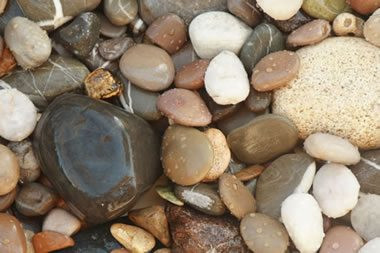 Pebbles on a beach, potential conglomerate clasts
Pebbles on a beach, potential conglomerate clasts
5. Where Is Conglomerate Rock Found?
Conglomerate rock can be found in many different locations around the world, depending on the geological history of the area. Some common locations where conglomerate can be found include:
- Sedimentary Basins: Sedimentary basins are areas where sediments have accumulated over long periods of time. Conglomerate is often found in sedimentary basins, particularly in areas where there were once rivers, beaches, or glaciers.
- Mountain Ranges: Mountain ranges are often sources of sediment for conglomerate formation. The erosion of mountains can produce large amounts of rock fragments that are transported and deposited in nearby basins.
- Coastal Areas: Coastal areas are subject to strong wave action, which can erode and transport rock fragments, forming conglomerate along beaches and shorelines.
- Glaciated Regions: Glaciers can carry large amounts of rock debris and deposit them in outwash plains and moraines. Conglomerate can be found in these glacial deposits.
5.1 Specific Examples of Conglomerate Rock Locations:
- The Alps: The Alps in Europe are a major source of conglomerate rock. The erosion of the Alps has produced large amounts of rock fragments that have been transported and deposited in surrounding basins.
- The Rocky Mountains: The Rocky Mountains in North America are another major source of conglomerate rock. The erosion of the Rockies has produced large amounts of rock fragments that have been transported and deposited in surrounding basins.
- The coast of California: The coast of California is home to many beaches and shorelines where conglomerate rock can be found. The strong wave action along the California coast erodes and transports rock fragments, forming conglomerate deposits.
- The Great Lakes region: The Great Lakes region of North America was once covered by glaciers. As the glaciers melted, they deposited large amounts of rock debris, including conglomerate, in outwash plains and moraines.
It’s worth noting that conglomerate rock can be found on other planets as well.
6. Conglomerate vs. Breccia: What’s The Difference?
Conglomerate and breccia are both clastic sedimentary rocks that are composed of large rock fragments cemented together. However, there is one key difference between the two:
- Clast Shape: Conglomerate is composed of rounded or sub-rounded clasts, while breccia is composed of angular clasts.
The rounded clasts in conglomerate indicate that the rock fragments have been transported over a long distance and have been abraded by water or wind. The angular clasts in breccia indicate that the rock fragments have not been transported far from their source and have not been significantly abraded.
6.1 Why is the Clast Shape Significant?
The clast shape is significant because it provides information about the origin and history of the rock fragments. Rounded clasts suggest that the rock fragments have been transported by water or wind and have been subjected to abrasion. Angular clasts suggest that the rock fragments have been formed by mechanical breakage and have not been transported far from their source.
6.2 When to Use Conglomerate vs. Breccia?
The choice between using conglomerate or breccia in a particular application depends on the desired aesthetic and the specific properties of the rock. Conglomerate is often preferred for decorative purposes due to its rounded clasts and smooth texture. Breccia is often used in construction due to its angular clasts, which provide good interlocking and stability.
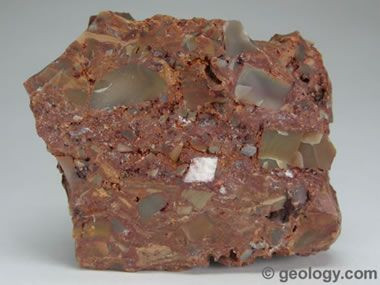 Breccia, a rock similar to conglomerate with angular clasts
Breccia, a rock similar to conglomerate with angular clasts
7. What Are The Different Types of Conglomerate Rock?
Conglomerate rock can be classified into different types based on various characteristics, such as composition, clast size, and matrix type. Here are some of the most common types of conglomerate rock:
- Quartz Conglomerate: This type of conglomerate is composed primarily of quartz clasts. Quartz conglomerate is typically very hard and durable due to the hardness of quartz.
- Limestone Conglomerate: Limestone conglomerate is composed primarily of limestone clasts. Limestone conglomerate is typically softer and more porous than quartz conglomerate.
- Granite Conglomerate: Granite conglomerate is composed primarily of granite clasts. Granite conglomerate is typically very hard and durable due to the hardness of granite.
- Polymict Conglomerate: Polymict conglomerate is composed of a variety of different rock and mineral clasts. Polymict conglomerate is typically less uniform in appearance and properties than monomict conglomerate.
- Intraformational Conglomerate: This type of conglomerate is composed of clasts derived from the same formation in which it is found. Intraformational conglomerate is typically formed by the erosion and redeposition of sediments within a basin.
- Extraformational Conglomerate: This type of conglomerate is composed of clasts derived from formations outside of the one in which it is found. Extraformational conglomerate is typically formed by the transport of sediments from distant sources.
7.1 How Do These Types Differ in Appearance and Properties?
The different types of conglomerate rock can vary significantly in appearance and properties:
- Composition: The composition of the clasts, matrix, and cement determines the overall appearance and properties of the conglomerate.
- Clast Size: The size of the clasts affects the texture and appearance of the conglomerate.
- Matrix Type: The type of matrix (sand, silt, or clay) affects the porosity and permeability of the conglomerate.
Understanding the different types of conglomerate rock is essential for selecting the right material for a particular application.
8. What Is Conglomerate Rock Used For?
Conglomerate rock has a variety of uses, although it is not as widely used as some other types of rock. Some common uses of conglomerate rock include:
- Construction Aggregate: Conglomerate can be crushed and used as a construction aggregate in concrete, asphalt, and other materials.
- Dimension Stone: Conglomerate can be cut into slabs and used as a dimension stone for building facades, paving stones, and other architectural elements.
- Landscaping: Conglomerate can be used as a decorative stone in landscaping projects. Its rounded clasts and colorful appearance make it an attractive addition to gardens, rockeries, and water features.
- Erosion Control: Conglomerate can be used to protect shorelines, riverbanks, and other areas from erosion. Its large size and weight help to stabilize the soil and prevent erosion.
- Mineral Exploration: Conglomerate can sometimes contain valuable mineral deposits, such as gold or uranium. Geologists can study conglomerate to identify potential mineral resources.
8.1 What Are The Advantages and Disadvantages of Using Conglomerate Rock?
Conglomerate rock offers both advantages and disadvantages for various applications:
Advantages:
- Aesthetic Appeal: Conglomerate has a unique and attractive appearance due to its rounded clasts and colorful composition.
- Durability: Some types of conglomerate are very hard and durable, making them suitable for use in construction and erosion control.
- Availability: Conglomerate is a relatively common rock type and can be found in many different locations.
Disadvantages:
- Variable Properties: The properties of conglomerate can vary significantly depending on the composition of the clasts, matrix, and cement.
- Weakness Planes: Conglomerate can sometimes be prone to fracturing along the boundaries between the clasts and the matrix.
- Limited Uses: Conglomerate is not as versatile as some other types of rock and has limited uses in certain applications.
Despite its limitations, conglomerate rock remains a valuable and aesthetically pleasing material for a variety of uses.
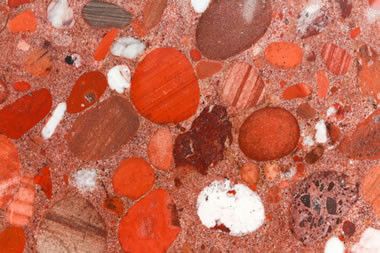 Red conglomerate slab
Red conglomerate slab
9. Conglomerate Rock in Landscaping: Ideas and Inspiration
Conglomerate rock can be a versatile and visually appealing addition to any landscaping project. Here are some ideas and inspiration for using conglomerate rock in your landscape:
- Rock Gardens: Conglomerate can be used to create stunning rock gardens. The rounded clasts and colorful composition of conglomerate add texture and visual interest to rock gardens.
- Water Features: Conglomerate can be used to create beautiful water features, such as waterfalls, ponds, and streams. The rounded clasts provide a natural and attractive look for water features.
- Pathways and Patios: Conglomerate can be used as a paving material for pathways and patios. The durable nature of conglomerate makes it a long-lasting and attractive option for paving.
- Erosion Control: Conglomerate can be used to protect slopes, shorelines, and other areas from erosion. The large size and weight of conglomerate help to stabilize the soil and prevent erosion.
- Retaining Walls: Conglomerate can be used to build retaining walls. The strong and durable nature of conglomerate makes it a reliable material for retaining walls.
9.1 How to Incorporate Conglomerate Rock into Your Landscape Design?
When incorporating conglomerate rock into your landscape design, consider the following tips:
- Choose the Right Size and Shape: Select conglomerate rocks that are appropriate for the scale of your landscape. Use larger rocks for focal points and smaller rocks for borders and ground cover.
- Consider the Color and Texture: Choose conglomerate rocks that complement the colors and textures of your existing landscape.
- Create a Natural Look: Arrange the conglomerate rocks in a way that mimics natural rock formations. Avoid creating overly symmetrical or artificial-looking arrangements.
- Combine with Other Materials: Combine conglomerate rock with other landscaping materials, such as plants, mulch, and gravel, to create a visually appealing and functional landscape.
Let your creativity flow and experiment with different ways to incorporate conglomerate rock into your landscape design.
10. How to Identify Conglomerate Rock?
Identifying conglomerate rock is usually straightforward due to its distinctive characteristics. Here’s a step-by-step guide:
- Observe the Texture: Look for a coarse-grained texture with large, rounded clasts that are easily visible to the naked eye.
- Examine the Clast Shape: Check if the clasts are rounded or sub-rounded, indicating that they have been transported and abraded by water or wind.
- Identify the Clast Composition: Determine the types of rocks and minerals that make up the clasts. Conglomerate can contain fragments of various rock types, such as granite, basalt, sandstone, and limestone, as well as mineral grains like quartz and feldspar.
- Analyze the Matrix: Examine the finer-grained material that fills the spaces between the clasts. The matrix is typically made up of sand, silt, and clay-sized particles.
- Look for Cementation: Check for the presence of cement that binds the clasts and matrix together. Common cementing minerals include calcite, quartz, and iron oxides.
- Compare to Reference Samples: If possible, compare the rock sample to reference samples of known conglomerate rocks to confirm its identification.
- Consult a Geologist: If you are unsure about the identification of a rock sample, consult a geologist or rock expert for assistance.
10.1 What Tools and Techniques Can Be Used to Identify Conglomerate?
In addition to visual inspection, the following tools and techniques can be used to identify conglomerate rock:
- Hand Lens: A hand lens can be used to magnify the clasts and matrix for closer examination.
- Acid Test: A drop of hydrochloric acid can be used to test for the presence of calcite cement. Calcite will fizz when it comes into contact with acid.
- Hardness Test: A hardness test can be used to determine the hardness of the clasts. Quartz, for example, is much harder than calcite.
- Petrographic Microscope: A petrographic microscope can be used to examine the mineral composition and texture of the conglomerate in detail.
With a little practice and the right tools, you can confidently identify conglomerate rock in the field.
11. What are Some Famous Conglomerate Formations Around The World?
Several notable conglomerate formations around the world showcase the beauty and geological significance of this rock type:
- The Old Man of Storr, Scotland: This iconic rock formation on the Isle of Skye features prominent conglomerate layers that add to its dramatic appearance.
- The Siyeh Formation, Glacier National Park, USA: This formation contains thick layers of conglomerate that were deposited during the Precambrian Era.
- The Table Mountain Sandstone, South Africa: This formation includes conglomerate layers that are known for their colorful clasts and scenic beauty.
- The Hammersley Basin, Australia: This basin contains extensive deposits of iron-rich conglomerate that are mined for iron ore.
- The Witwatersrand Basin, South Africa: This basin is home to some of the world’s largest gold deposits, which are found in ancient conglomerate riverbeds.
11.1 What Makes These Formations Special?
These conglomerate formations are special for a variety of reasons:
- Geological Significance: They provide valuable insights into past geological conditions, such as the presence of ancient rivers, mountains, and shorelines.
- Economic Importance: Some conglomerate formations contain valuable mineral resources, such as gold, iron, and uranium.
- Scenic Beauty: The colorful clasts and unique textures of conglomerate make it an attractive addition to landscapes and rock formations.
These famous conglomerate formations offer a glimpse into the Earth’s dynamic history and the forces that have shaped our planet.
12. Is Conglomerate Rock Valuable?
The value of conglomerate rock depends on several factors, including its quality, composition, and location. Here’s a breakdown of the factors that influence the value of conglomerate rock:
- Quality: High-quality conglomerate rock is typically hard, durable, and free of fractures or other defects.
- Composition: Conglomerate rock that contains valuable minerals, such as gold or uranium, is more valuable than conglomerate rock that does not.
- Location: Conglomerate rock that is located near markets or transportation routes is more valuable than conglomerate rock that is located in remote areas.
- Demand: The demand for conglomerate rock can fluctuate depending on market conditions and the availability of other materials.
12.1 How is Conglomerate Rock Valued in Different Contexts?
Conglomerate rock is valued differently depending on the context:
- Construction: Conglomerate rock that is used as a construction aggregate is typically valued based on its strength, durability, and availability.
- Landscaping: Conglomerate rock that is used for landscaping purposes is valued based on its aesthetic appeal, size, and shape.
- Mineral Exploration: Conglomerate rock that is being explored for mineral deposits is valued based on the potential for finding valuable minerals.
While conglomerate rock may not be as valuable as some other types of rock, it can still be a valuable resource in certain contexts.
13. How to Maintain Conglomerate Rock in Your Landscape?
Maintaining conglomerate rock in your landscape is relatively simple. Here are some tips to keep your conglomerate rock looking its best:
- Clean Regularly: Clean the conglomerate rock regularly with a brush and water to remove dirt, debris, and algae.
- Remove Stains: Remove stains from the conglomerate rock with a mild detergent or a commercial stone cleaner.
- Seal the Stone: Seal the conglomerate rock with a stone sealant to protect it from weathering and staining.
- Repair Damage: Repair any cracks or chips in the conglomerate rock with a stone repair compound.
13.1 Tips for Preserving Its Natural Beauty?
To preserve the natural beauty of conglomerate rock in your landscape, follow these tips:
- Avoid Harsh Chemicals: Avoid using harsh chemicals or abrasive cleaners on the conglomerate rock, as they can damage the stone.
- Protect from Weather: Protect the conglomerate rock from extreme weather conditions, such as freezing temperatures and heavy rain, by covering it with a tarp or plastic sheet.
- Provide Proper Drainage: Ensure that the area around the conglomerate rock has proper drainage to prevent water from pooling and causing damage.
With proper care and maintenance, conglomerate rock can retain its natural beauty and enhance your landscape for many years to come.
14. What is Puddingstone Conglomerate?
Puddingstone is a descriptive, non-scientific name applied to conglomerate that has a distinctive appearance with colorful, contrasting clasts embedded in a matrix of a different color. The term “puddingstone” is derived from the rock’s resemblance to a traditional English plum pudding, with its scattered fruits in a light-colored batter.
14.1 Where Can You Find Puddingstone?
Puddingstone can be found in various locations around the world, including:
- Hertfordshire, England: Hertfordshire puddingstone is a well-known variety of puddingstone that is found in the London Basin. It is characterized by colorful flint pebbles in a white to brown silicate matrix.
- Michigan, USA: The state stone of Michigan is the Petoskey stone, which is a fossilized coral conglomerate that is often referred to as puddingstone.
- Other Locations: Puddingstone can also be found in France, Canada, India, Maryland (USA), and even on Mars.
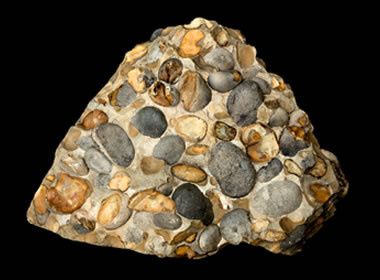 Puddingstone conglomerate
Puddingstone conglomerate
15. Conglomerate Rock on Other Planets
The discovery of conglomerate rock on Mars by NASA’s Curiosity rover in 2012 provided strong evidence that water once flowed on the surface of the red planet. The rounded clasts within the Martian conglomerate suggest that they were transported and abraded by water, similar to how conglomerate rocks are formed on Earth.
15.1 What Does It Tell Us About Extraterrestrial Environments?
The presence of conglomerate rock on Mars tells us that:
- Water Existed on Mars: The rounded clasts provide evidence that liquid water once existed on the surface of Mars.
- Mars Had a Dynamic Environment: The transportation and deposition of sediments indicate that Mars had a dynamic environment with flowing rivers or streams.
- Mars May Have Been Habitable: The presence of water and a dynamic environment suggests that Mars may have been habitable in the past.
The discovery of conglomerate rock on Mars has revolutionized our understanding of the red planet and its potential to have supported life.
16. FAQ about Conglomerate Rock
Here are some frequently asked questions about conglomerate rock:
16.1 Is conglomerate rock suitable for all climates?
Yes, conglomerate rock is generally suitable for all climates, but certain types may be more resistant to weathering in extreme conditions.
16.2 How can I clean conglomerate rock?
Conglomerate rock can be cleaned with a brush and water, or with a mild detergent for stubborn stains.
16.3 Is conglomerate rock expensive?
The cost of conglomerate rock varies depending on its quality, location, and demand.
16.4 Where can I buy conglomerate rock?
Conglomerate rock can be purchased from stone suppliers, landscaping companies, and construction material retailers.
16.5 Can I use conglomerate rock in a fish pond?
Yes, conglomerate rock can be used in a fish pond, but it is important to clean it thoroughly before placing it in the water.
16.6 Is conglomerate rock radioactive?
Most conglomerate rock is not radioactive, but some types may contain small amounts of radioactive minerals.
16.7 How can I tell if a rock is conglomerate?
Conglomerate rock can be identified by its coarse-grained texture, rounded clasts, and cementation.
16.8 What is the difference between conglomerate and sandstone?
Conglomerate is composed of rounded gravel-sized or larger clasts, while sandstone is composed of sand-sized grains.
16.9 Can conglomerate rock be polished?
Yes, conglomerate rock can be polished to enhance its appearance and smooth its surface.
16.10 Is conglomerate rock a good choice for a driveway?
Conglomerate rock can be a good choice for a driveway if it is properly installed and maintained.
Ready to explore the beauty and versatility of conglomerate rock for your next landscaping project? Visit rockscapes.net today to discover a wide selection of conglomerate rocks, get inspired by stunning design ideas, and receive expert advice from our experienced team. Let us help you transform your outdoor space into a captivating oasis with the timeless appeal of natural stone. Contact us at 1151 S Forest Ave, Tempe, AZ 85281, United States, call +1 (480) 965-9011, or visit our website at rockscapes.net to get started!